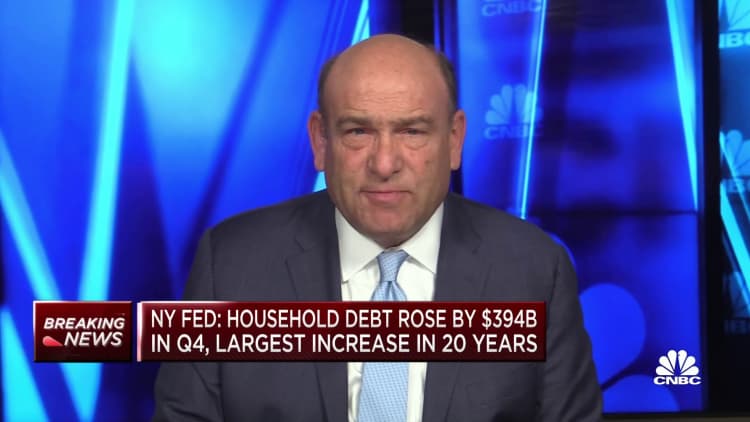[ad_1]
Valentinrussanov | E+ | Getty Images
High inflation is leading to reduced savings and higher credit card debt — and there are some signs households may be reaching a tipping point under increased financial pressures.
A new survey from Bankrate finds 39% of individuals surveyed in January said their emergency savings are less than they were last year. Meanwhile, 10% still have no cash set aside – the same finding as in last year’s survey.
The results come as total household debt increased by 2.4%, to $16.9 trillion, in the fourth quarter of last year, the Federal Reserve Bank of New York announced last week. For all debt types, the share of current debt that became delinquent, where payments have not been made under the agreed terms, also increased in the fourth quarter.
An “ugly stew is brewing” as people buckle under the pressure of inflation, especially if they don’t have a lot of savings, noted Bruce McClary, senior vice president of the National Foundation for Credit Counseling.
Those individuals and families may turn to open lines of credit to help fill the gaps in their budgets — to pay for groceries or gas, for example. As interest rates rise, it has become harder to pay off those debt balances they’re carrying, according to McClary.
“It’s that combination of everything that is starting to push people over the edge,” he said.

More than a third — 36% — of the 1,032 respondents to Bankrate’s January survey said their credit card debt is higher than their emergency savings — a record high over the 12 years the poll has been conducted.
Still, slightly more than half of respondents — 51% — said they have more emergency savings than credit card debt. The remaining 13% have no credit card debt nor any emergency savings.
‘Younger workers are more financially fragile’
Younger generations are more likely to feel the financial strain, according to Mark Hamrick, senior economic analyst at Bankrate.
“Broadly speaking, younger workers are more financially fragile,” particularly if they are new to the work force, Hamrick said.
Bankrate’s survey found 45% of millennials, 44% of Gen Xers and 38% of Gen Zers have more credit card debt than money in savings. In comparison, just 25% of baby boomers said the same.
If we have one mantra, it is it pays to shop around for the best rate.
Mark Hamrick
senior economic analyst at Bankrate
Credit-counseling requests rise, as do stress levels
The New York Fed’s quarterly household debt and credit report found younger borrowers are showing signs of financial stress and are beginning to miss some credit card and auto loan payments.
The risk of delinquencies may continue based on the economy, according to Hamrick.
“Just having a job doesn’t solve the problem,” he said.
In recent months, the number of requests for credit-counseling sessions has increased, according to McClary. The number of people who receive a recommendation to start a debt-management plan after completing a counseling session is also up, he noted.
“We’re starting to see that uptick in volume,” McClary said. “That alone tells me that the number of consumer-credit delinquencies is likely going up.”
If you think you’re at risk of falling behind on your bills, do not wait to take action, McClary advised.
When people are facing delinquencies, they often skip the first step, which is to simply reach out and talk to their creditor, he said.
Renegotiating the terms of your debt early on may help avoid a financial disaster later on, McClary said.
If you don’t pay your account as agreed, that can have certain consequences. If your account is 30 days past due, you will likely incur a fee and also possibly a higher interest rate, which makes it more difficult to get back on track.
Once a bill is 60 days past due, a creditor is likely to report it to the credit bureau. Your credit score will likely be reduced, which can make it difficult to get the best rates on future loans or lines of credit, McClary noted.
Once it gets to 90 days past due, a creditor usually sends the bill to a collection agency and your account may be closed.
“The longer you wait without taking action, the worse your circumstances may get,” he added.
Contacting a nonprofit credit counseling agency for advice may also help connect you with a financial professional who can explain your options, McClary said.
[ad_2]
